Ultimate guide to buying a round baler 2023
Packing more material into every bale and increasing amounts of automation are common themes among the new and improved machines featured in our Ultimate Guide to round balers.
Out go the most basic-spec Claas Rollant 520 Rake model with its feed-in tines, the New Holland Roll-Bar BR6090 and top-spec Automate versions of the Kuhn FB3135 baler and baler-wrapper.
But there are newcomers from Case IH, Claas and New Holland, uprated machines with new features from Fendt, Massey Ferguson and McHale, and the return of the baling and wrapping version of Wolagri’s diminutive R500 mini round baler.
See also: McHale launches Fusion 4 combi baler-wrapper
Round baler specs
Case IH
Case IH has topped out its range of variable-chamber round balers with the new RB 456 HD Pro and RB 466 HD Pro featuring heavier-duty components and fewer moving parts than previous models.
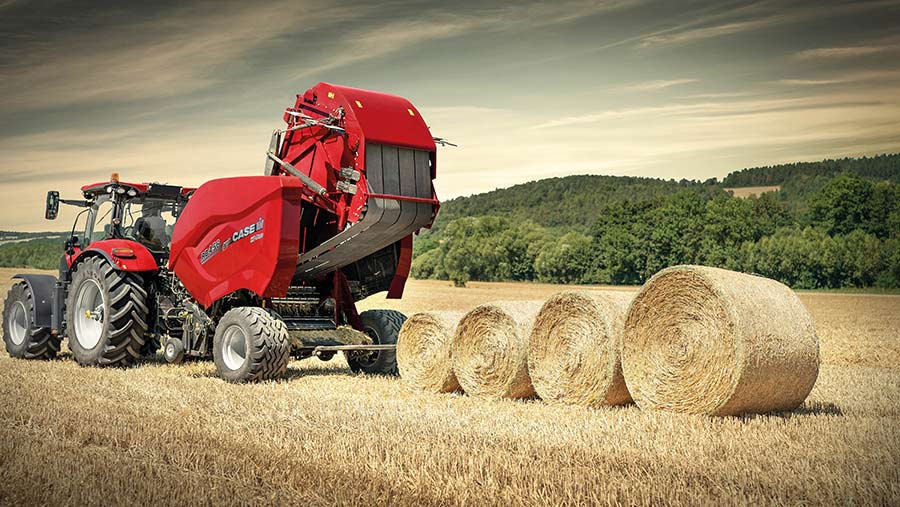
Case IH RB 456 HD Pro makes bales up to 1.6m diameter in 5cm increments © Case IH
The two are aimed at contractors and larger livestock producers needing the durability to put a lot of hours on their machine producing 10,000 or more bales a year and wanting high capacity too; the newcomers are reckoned to handle up to 30t/hour.
Rolling up bales from 0.9m to 1.65m and 1.9m diameter, respectively, the newcomers are said to be equipped to tackle a wide range of crops and conditions from dry straw to hay, haylage and silage grass of any length.
Behind the pick-up reel with its swath roller, there are stub axles to bring wide swaths to the intake, with an optional full-width paddle roller providing added encouragement.
Buyers then get the choice of a plain single-tine intake rotor without crop slicing or double-tine rotors with either 13 or 25 knives to suit different crop chop preferences.
Upgrades include strengthened and enlarged belt rollers, shafts and tailgate, and a heavier duty gearbox and driveline.
Things have been simplified in places – such as a reduced number of drive chains – to help reliability and reduce maintenance requirements.
From an operational point of view, the changes include a more effective design of drop floor to help clear plugs from the intake area.
The revised bale chamber and belt path, and the use of drive rollers driven from both ends, is said to result in neatly formed, denser bales.
Claas
The new Variant 500-series variable-chamber round balers from Claas retain the two-arm density control mechanism of their predecessors, but now have separate pressure regulation to allow greater manipulation of the bale structure.
As with the Variant 400-series, the four-belt machines are available in the UK with plain Roto Feed intake or crop slicing Roto Cut, but with the latter in 17-knife (rather than 14-knife) configuration and to HD specification with reinforced drive chains.
The 560 Roto Feed Pro and 565 Roto Cut Pro makes bales from 0.9m to 1.6m diameter, while the Variant 580 and 585 versions go to 1.8m.
All four versions have the Claas Pro drop-floor as standard, which can be deflected by 30mm to allow for variations in swath density.
An acoustic signal is given if an impending blockage is likely, giving time for the operator to slow down.
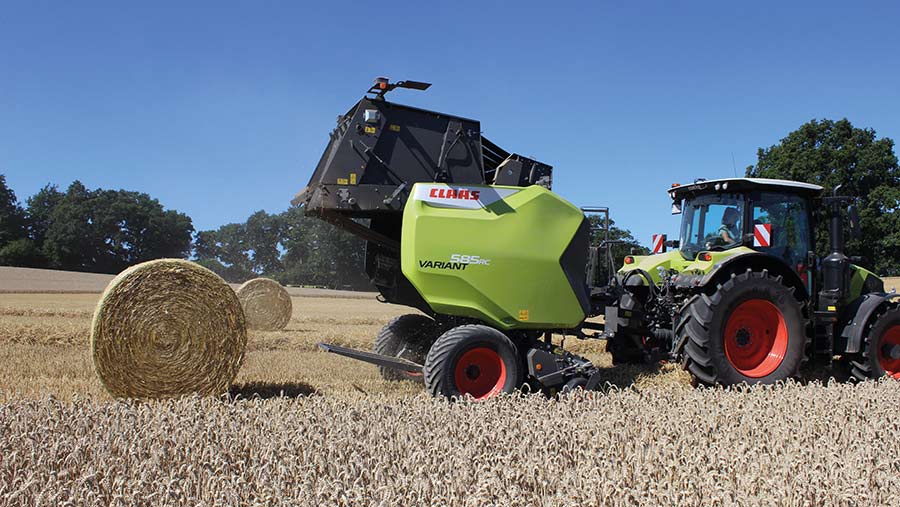
New Claas Variant 585 Roto Cut baler has separate control of the two belt tensioning arms © Peter Hill
If a blockage does occur, a button press lowers the floor panel and depressurises the knives so that the twin-tine, four-star rotor can be restarted to shift the material.
The revamped bale density management system comprises a new hydraulic distribution block with independent lines for each of the belt tensioning arms.
There are default settings for different crops accessed through the new Cemis 700 or other Isobus terminals, but operators can also set up their own belt tension profiles depending on the crop, conditions on the day and end uses.
Essentially, though, the new mechanism and software allow more precise adjustment of the soft core favoured when baling hay, as well as greater density in the outer layers of the bale for increased weights and weather resistance.
Over-the-shoulder netting is now standard on the balers from 1.3m-wide rolls that sit 25cm lower than before for easier change-overs.
And the new feed plate, knife and net brake – designed to provide consistent tension regardless of roll diameter – further add to the Variant’s performance.
Other changes include a reshaped chassis that allows larger tyres up to 560/45 22.5 to be fitted, in-line filters and colour-coded plug-in couplers for the hydraulics.
There are also easier to set pick-up wheels, a more economical auto oiling system for drive chains, and multiple greasing blocks are positioned so they are accessible from the ground.
Fendt
A more accurate record of forage in store and the ability for contractors to charge by tonnage rather than by bale are features claimed for new options on Xtra versions of Fendt Rotana round balers.
The bale-weighing option comprises three weigh cells and a control system that compares the weights of the baler taken before and after each bale has been discharged and with the pick-up automatically raised.
Fendt says there is no need to repeatedly calibrate the system once set up.
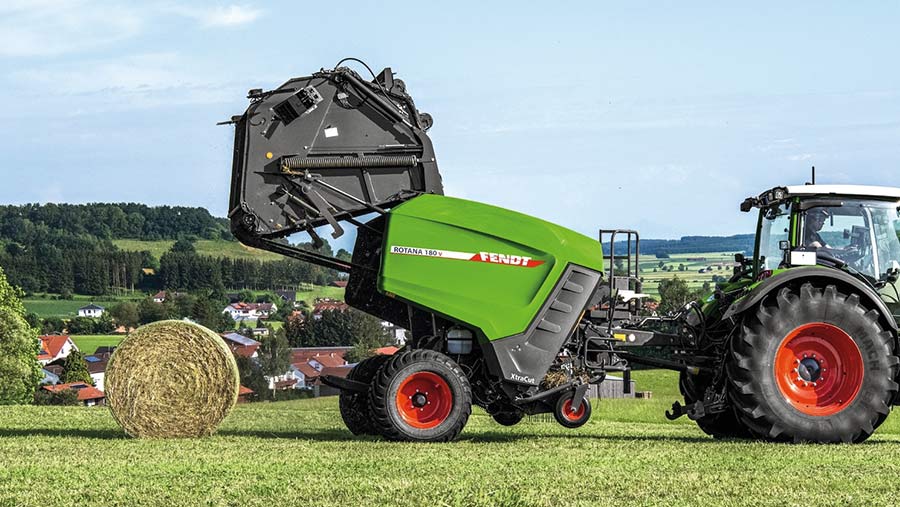
Isobus TIM automation can bring the Fendt Rotana’s tractor to a halt for netting © Fendt
Two sensors on the inner wall of the bale chamber measure the moisture content of baled material.
To minimise the risk of spoilage in store, an alarm can be set if it exceeds an adjustable upper limit.
Damper areas of crop can then be avoided or bales segregated for further drying.
To reduce the operator’s workload, the Rotana Xtra balers can be operated with automatic tailgate open and close.
Tractors with the Isobus Tractor Implement Management (TIM) function can automatically be brought to a halt when each bale is ready for netting.
During that process, the crop-slicing knives are retracted and deployed again to clear the slots of any material.
In addition, operators cutting straw can select to automatically withdraw the knives to finish the bale with a stabilising uncut layer of adjustable depth.
A new LED lighting pack is available to illuminate the area under the baler side shields.
On Rotana variable bale size machines, automatic bearing lubrication on all belt rollers can be added.
McHale
While retaining the crop moisture and bale weighing options of its predecessors, operators of the fourth-generation Fusion integrated baler/wrapper from McHale Engineering can now access these and other control features via Isobus.
This electronics upgrade installed on the “Pro” and “Plus” versions provides a familiar graphics interface and the ability to connect via a tractor’s integrated or third-party displays.
There is also a kit option to operate Isobus functions on non-Isobus tractors.
Across the three-model Fusion 4 range, McHale has increased bale density pressure and introduced a heavier-duty pick-up and revised intake area designed to improve crop flow for increased productivity through reduced risk of blockages.
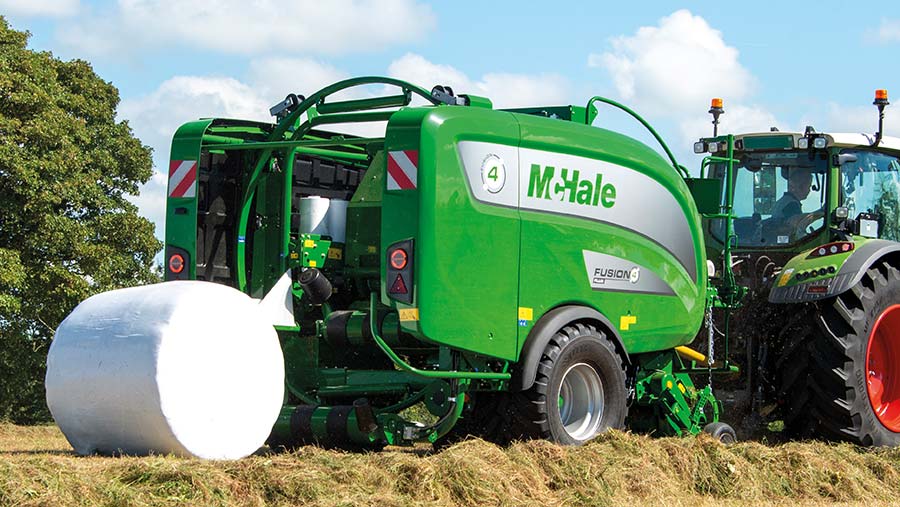
A heavier duty pick-up and revised intake area feature on McHale’s Fusion 4 © McHale
There is a choice of 2.1m-wide cam-controlled (standard) and camless (optional) pick-ups, the latter having a slightly wider effective working width and a simpler structure, both driven by heavier-duty chains.
The Profi-Flow design positions the scraper bands and side gathering augers closer to the intake rotor.
Tapering the augers and removing steel hydraulic pipes from above the pick-up has opened up the intake area, where a bed plate automatically adjusts to the volume of material coming in.
In addition to the standard 540rpm gearbox, the Fusion 4 can now be equipped with a 1,000rpm unit for greater fuel economy when run at the recommended 890rpm operating speed.
There are also grease and oil pumps connected to the bale-tipping device to lubricate bearings and drive chains every time a bale is produced.
More economical use of net – but especially of film applied around the bale circumference on the Plus version – is promised thanks to a larger roll brake.
The machine can be set up to retract the knives so that a non-chopped outer layer stabilises the finished bale.
Massey Ferguson
New automation features for Massey Ferguson RB-series round balers are designed to reduce the operator’s workload and fatigue over long days.
Repetitive control functions are automated, and with the Isobus TIM option, even bringing the tractor to a halt requires no operator involvement.
The RB-series encompasses the entire portfolio of MF balers, from the 18-roller RB 3130F producing 1.25m-diameter bales to the RB 4160V and RB 4180V roller and belt machines, which turn out packages from 0.9m to 1.6m and 1.8m, respectively.
With the Exclusive option, available on Xtra specification balers but not the base Classic versions, the system automatically raises the pick-up when reversing ready to net a bale, and during that process the crop slicing knives are retracted to clean off any debris.
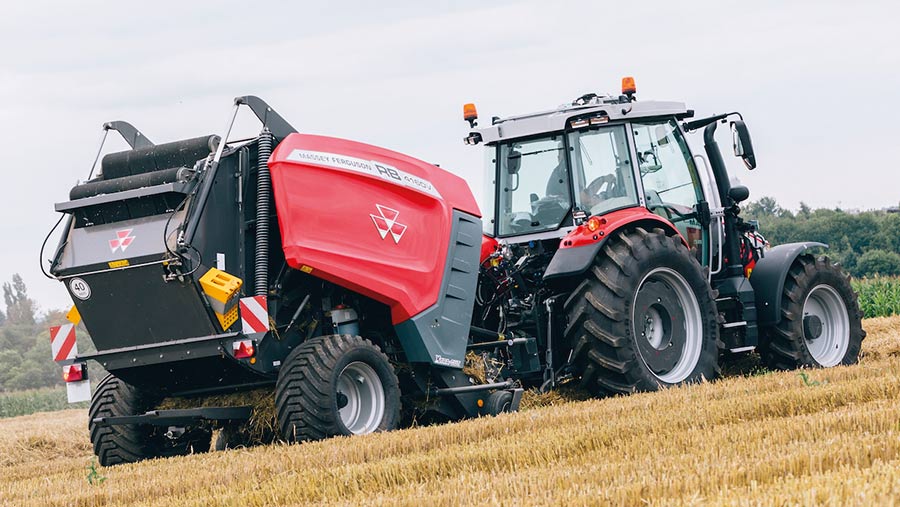
Automatic tailgate open/close is among new features for the Massey Ferguson RB 4160V baler © Massey Ferguson
With netting completed, the tailgate pops open without prompting and closes again once the “kicker” registers that the bale has been discharged.
In addition, the system can be set up to retract the knives when the final bale layers are being applied in order to produce a firm, flat finish.
Equipment-wise, the Exclusive package includes moisture measurement and bale weighing using sensors in the bale chamber, and LED maintenance and servicing lights.
While that package requires a tractor with load-sensing hydraulics, the alternative Exclusive TIM option does not.
In this case, balers operated by tractors with Isobus TIM capability have the same automated features and equipment but also tractor clutch control – to bring the tractor to a stop, at least.
Once the netting process is complete, the operator must set the tractor going again.
Massey Ferguson has also introduced a new baler terminal for non-isobus tractors to replace the E-Link controller.
MF BaleControl has a 5in touch-screen display, includes features from the more advanced E-Link Pro unit and covers more functions.
In addition, automatic greasing – including all bearings supporting rollers – has become available as an option for the variable bale size balers and is standard on the Protec baler-wrapper machines, which feature a redesigned tipper to flip bales on-end.
New Holland
The all-new Pro-Belt variable-chamber machines extend the New Holland round baler range with build specifications and features catering for high-hours operators among large farms and contractors.
There are 165 and 190 models forming bales from a minimum of 90cm diameter to 1.65m and 1.90m in 5cm increments, and a choice of SuperFeed plain rotor intake and CropCutter twin-tine rotor intake with crop slicing knives.
All variants form bales using a pair of fixed rollers (fewer than on other New Holland round balers) and four 273mm endless belts powered by two drive rollers.
The initial formation is said to have the ability to get material of all types rolling and to then create a tight or soft core to the as required.
Two coil springs provide initial tension and then two hydraulic cylinders offer adjustable density control as the bale progresses in size.
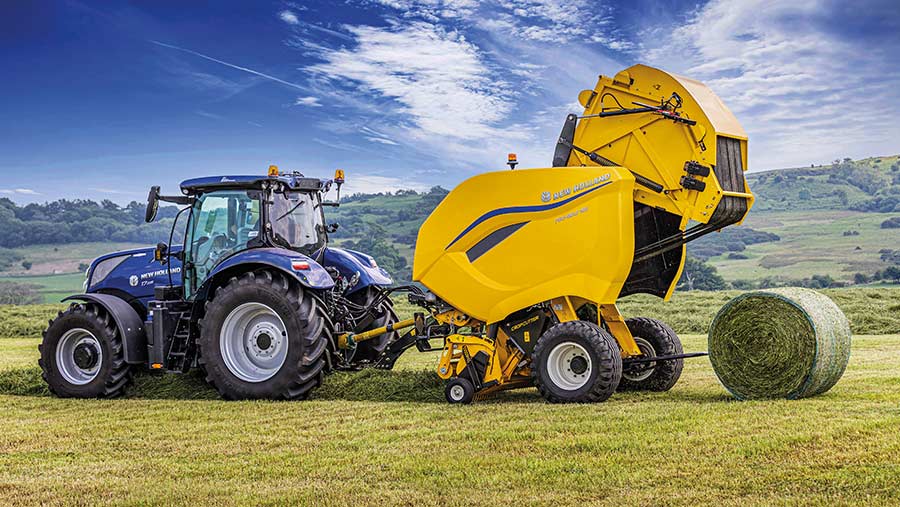
New Roll-Pro is a top-end addition to the New Holland round baler range © New Holland
Up front, the balers are equipped with a five-bar pick-up reel and free-wheeling swath roller, then an optional feed roller with auger flights either side of a paddle section to encourage high volumes of material to the feed rotor.
A split driveline sends torque to the right to drive the belt rollers and to the left for the intake elements, with large sprockets and chains providing a robust solution for durability over a high workload.
The Pro-Belt machines come with Isobus control as standard, including automation that can bring the tractor to a halt, initiate netting and open and close the tailgate.
There is also a moisture-measuring option using disc sensors on either side of the bale chamber, and New Holland’s MyPLM Connect telematics enables wireless data exchange to and from the machine.
Wolagri
With the Italian manufacturer Tonutti Wolagri having resumed production of the R500 mini baler with integrated wrapper, importer Marrs of Methlick has brought machines into stock once more.
The R500 Combo baler-wrapper produces a 63cm wide, 57cm-diameter bale using 19 aluminium rollers, and with hydraulic pressure determining ultimate bale density, before a twin-roll orbital arm wrapping system encloses them in stretch film.
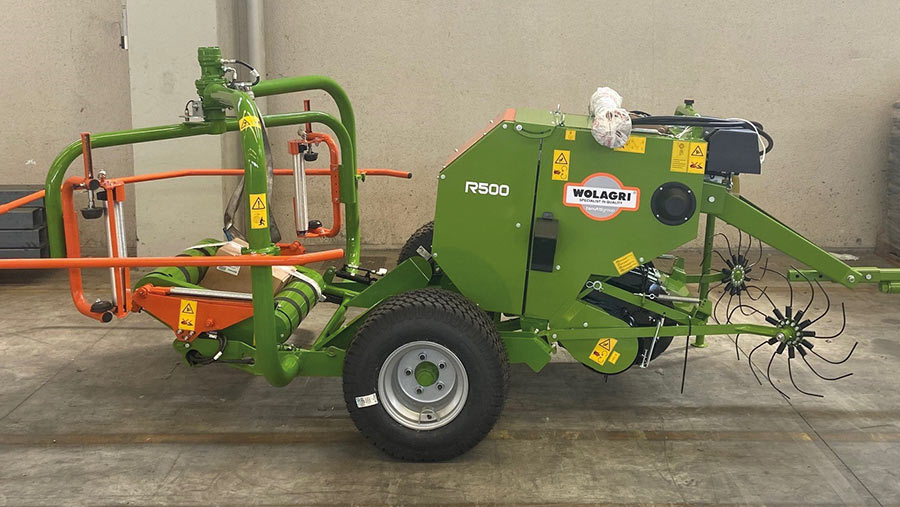
Back in production – the Wolagri R500 Combo mini baler-wrapper © Wolagri

